Here you have backpacks from two industry giants, Deuter Aircontact Core 50 + 10 versus Osprey Atmos AG LT 65. Deuter boasts a legacy that stretches back to the 19th century, while Osprey stands as a trailblazer with an extensive array of packs and groundbreaking designs.
Both the Aircontact Core and Atmos AG LT series emerged recently introducing new sub-series that have captivated adventurers worldwide.
Join me here in dissecting the nuances, similarities, and distinctive features of these packs, guiding you through an informed choice in this head-to-head battle of backpack supremacy.
I have tested both backpacks in the same conditions and with the same load. While I like the Osprey Atmos AG LT 65 pack more, for me the Deuter Aircontact Core 50 + 10 pack works better for heavier loads.
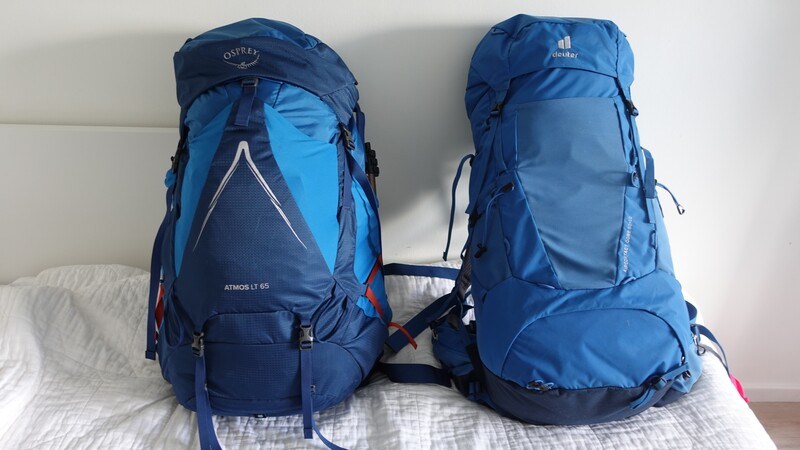
Why this Osprey Atmos AG LT 65 and Deuter Aircontact Core 50+10 comparison
• Here you have two top brands in the backpack industry. No other brand has been around longer than Deuter, and no brand can match Osprey with the number of packs on the market and innovations they have introduced so far.
• On the other hand, both backpacks discussed here appeared as parts of their corresponding series in the same season.
• The Deuter Aircontact has been around for many years and this is the best known series from Deuter. But the Core is a new addition, a sub-series in the group.
Something similar holds for the Osprey Atmos (and Aura for women) AG, these are the best known series of Osprey. However, the LT appears as a new sub-series in the AG group. You can read more in my another text.
• Both packs are good, or better to say great, but they are not really the best in their general groups, I mean Aircontact and Atmos & Aura AG main series.
So, in the case of Deuter, it is the Deuter Aircontact X that is the best, and most likely the best they have ever built. On the other side, the Osprey Atmos & Aura AG LT are definitely inferior to the standard Osprey Atmos & Aura AG packs.
• Finally, there are some similarities between them, and those are given below.
Osprey Atmos AG LT 65 and Deuter Aircontact Core 50+10 similarities
I would point out the following, the list is not necessarily definite:
- Both backpacks have an adjustable torso length. But indeed, the designs are completely different (see the picture below); one is ladder type (Osprey) and the other is continuous type (Deuter’s pack).
- Both packs are with the official load capacity that is almost the same. You have up to 40 lb (18 kg) in the Osprey’s pack, and up to 44 lb (20 kg) in the Deuter’s pack. But is this realistic? More about this below.
- They have the same number of pockets.
- The materials in both are bluesign approved.
- The denier values of the fabric is similar, and both are made of nylon. I would describe them both as moderately durable.
- Both have a floating and removable lid, and a top collar access point. But there is more to this, you will see below.
- These packs are more or less in the same group regarding the weight. I would describe them as moderately light.
- Both come with a rain cover included.
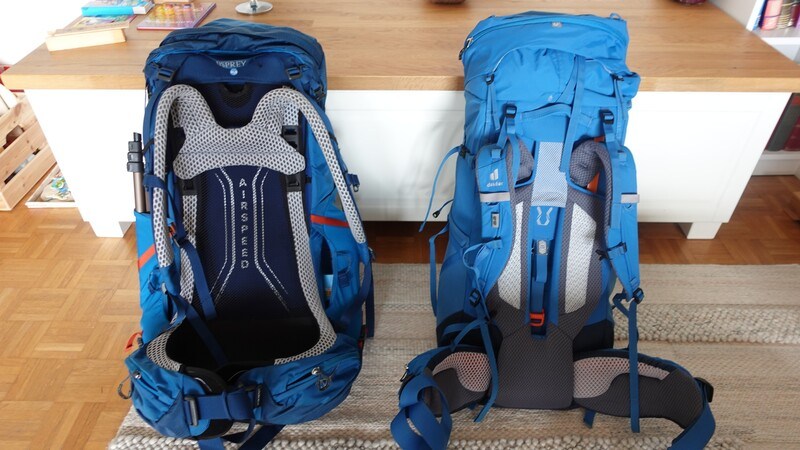
Differences and my rating
I have decided to start with the table below. In the first column you have listed some features where these packs differ a lot. In the remaining columns you can see where I give advantage (thumb-up):
Ventilation
Pockets
Shoulder harness comfort
Hip belt design
Squeaking
Overall weight carry comfort
Access
Pivoting shoulder straps
Volume/Weight ratio
Lidless use
Price
Deuter Aircontact
Core 50+10
Osprey Atmos
AG LT 65
Let me explain my reasons for such a vote.
Ventilation
Regarding ventilation, you will not find a better design than what you have in the Osprey Atmos AG LT 65 pack. Only Osprey’s own backpacks from the standard Atmos & Aura AG series have the same design.
The picture below shows how it looks; the backpack is completely separated from the body and only mesh is in contact with your back.
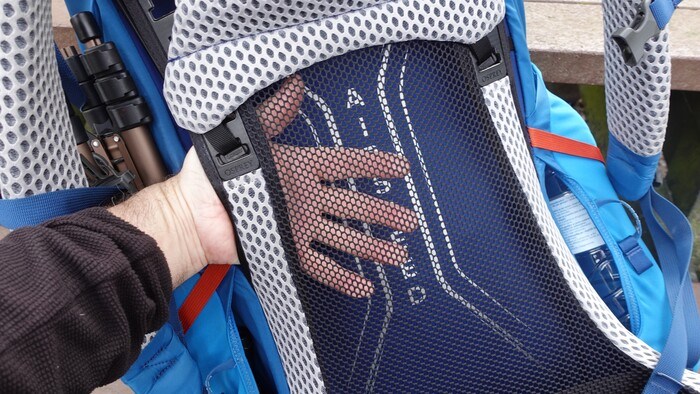
Observe also how the harness attaches to the mesh panel; this is the ladder type design mentioned above.
This is not only about the back panel ventilation. The 3D tension mesh continues all the way from the top to the bottom and then it continues to the big part of the hip belt as well. You can see this in the picture below.
All in all, this is a backpack ventilation at its best.
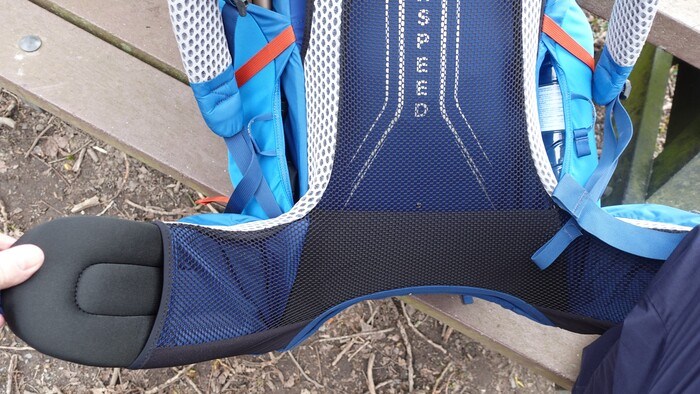
In the picture above you can see also one of the hip belt fins; so it all can be repositioned where you want it to be around your hips.
Pockets
It is interesting that both backpacks have the same number of pockets, and this is 6. However, I give the advantage to the Osprey Atmos AG LT 65 pack because of the following:
- Its hip belt pockets are much larger.
- Its front pocket is with a buckle.
- Its side stretch mesh pockets are gigantic.
- The lid pocket in the Osprey’s pack is bigger.
Shoulder harness comfort
Here I give advantage to the Osprey Atmos AG LT 65 pack because the padding is softer and the straps are a bit wider. The picture below shows its details. Note also that even this part is completely ventilated. The pipe port is visible.
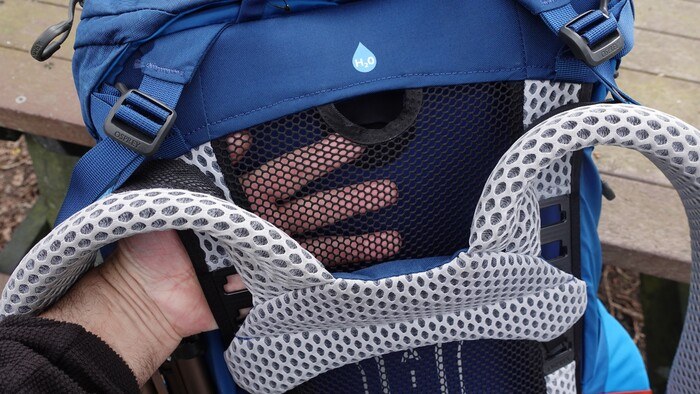
When I was carrying the Deuter Aircontact Core 50 + 10 pack, with exactly the same load, I felt that the shoulder straps were a bit cutting into my shoulders. The shoulder harness padding in this pack is a bit harder.
Hip belt design
This is a bit tricky, and I shall explain why this is so.
What you have in the Osprey Atmos AG LT 65 pack is incredibly beautiful and functional, and here are details that I like:
- There is ventilation even in the hip belt as explained above.
- The hip belt fins are adjustable, they call this Fit-on-the-Fly hip belt. You can break the Velcro hook and loop connection and reposition the padding as it suits you best. This may be very useful for people with a larger body.
But there are details that I dislike in this pack:
- One detail is that front straps on the hip belt are incredibly long, I had two pieces of straps of around 50 cm or so hanging in front of me.
- More importantly, after some time of carrying the loaded pack, I feel that the lower edge of the hip belt cuts into my hips. This is on the back area close to the region where the peripheral frame ends. I have seen some other users also reporting about this.
On the other hand, in the Deuter Aircontact Core 50 + 10 pack you have a completely different design with an incredibly thick and effective dual-foam padding. The lumbar padding is almost like a pillow, see the picture. After carrying the same load in both packs, I have no doubt at all that this pack works better for me.
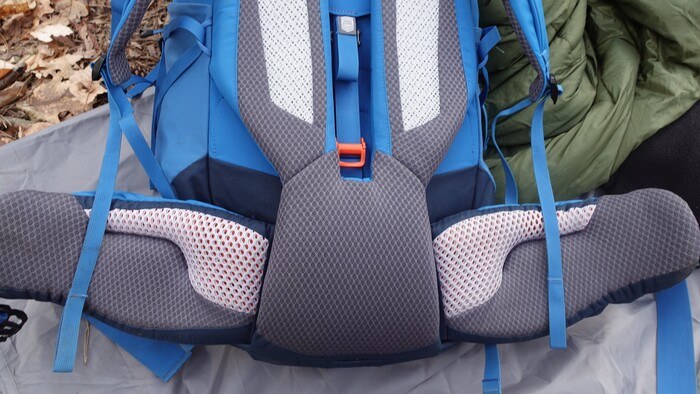
However, the hip belt padding on the sides is surprisingly short. It is perfect for me, but I suspect that people with a larger body size may not have long enough hip belt fins.
I would conclude that for me, the Deuter pack would always be better, and in particular for heavier loads. The design of Osprey pack’s hip belt is hard to match, but this does not make it good enough for me. So I give advantage to Deuter, but I would say this is far from an easy choice for me.
Squeaking
You know what, this appears to be a part of the package – if you want a ventilated trampoline-type back panel design, you will hardly avoid it. The Osprey’s pack indeed squeaks, and the same is with my own Deuter Futura pack.
With the Deuter Aircontact Core 50 + 10 pack you do not have any annoying sound, and if you are sensitive, this is something to definitely bear in mind.
Overall weight carry comfort
I wish to stress that for the purpose of testing, I have carried both packs with exactly the same load.
The hip belt plays a crucial role here. There is no doubt for me which pack I would choose for any heavier load, this would definitely be Deuter. This in spite of the fact that, as you have seen above, I give advantage to Osprey’s pack for the harness and hip belt features. But I must admit that I like the Osprey’s pack more.
Access
Both packs have a top access through a collar under the lid. Also both have extra access point.
In the case of the Osprey Atmos AG LT 65 this is a J-shaped side zippered assess. This access is far from convenient, under straps and I do not use it.
In the Deuter Aircontact Core 50 + 10 you have a bottom zippered access to a separate sleeping bag compartment. Inside, there is a true divider with a zipper.
In my view the Deuter’s pack is far more functional from this perspective.
When you know this, you realize that a bit more weight in the Deuter’s pack is justified, it is partly due to this inner divider with its strong and durable zipper.
Pivoting shoulder straps
The Deuter Aircontact Core 50 + 10 backpack has shoulder harness attachment with what they call the VaryFlex design.
This is a pivoting feature, which means that the straps’ attachment is not fixed, and this is far more user friendly design. People with a wider body will definitely appreciate this detail, the harness naturally adjusts to the body of the user.
Volume/Weight ratio
The Osprey Atmos AG LT 65 backpack weighs 4.068 lb (1.845 kg). So its Volume/Weight ratio is very good 35 liters/kg.
In the Deuter Aircontact Core 50 + 10 pack you have 4.762 lb (2.16 kg), so the Volume/Weight ratio here is 28 liters/kg.
The winner is obvious, but as mentioned, the Deuter pack is heavier partly due to its inner divider with its zipper, and due to its massive lumbar padding.
Lidless use
As mentioned above, both packs have a removable lid. Now, when you remove the lid in Deuter’s pack, it look ugly and incomplete. There is only a top compression strap, which is good in general. But I do not think I would ever use this pack without the lid.
On the other hand, the Osprey Atmos AG LT 65 backpack comes equipped with an integrated flap for lidless use, see the picture below. It has buckles that match those on the front used for the lid closure. So when the lid is removed, you can nicely close the pack and it looks complete. It is lighter and it looks smaller as well.

Price
Currently, the Deuter Aircontact Core 50 + 10 pack is more affordable, at least on the US market. But in Europe, you will find them for nearly the same price.
Places to buy
Deuter Aircontact Core 50 + 10 pack is available at:
Osprey Atmos AG LT 65 pack you can find here:
Final thoughts
In conclusion, this Deuter Aircontact Core 50 + 10 vs Osprey Atmos AG LT 65 comparison is a close call as you realize from the text above.
I like the Osprey’s pack more, but the Deuter’s pack fits me better. I have tested them with exactly the same weight and on the tours of the same length, so I am sure about my statement.
It is essential that you try the packs, we are all differently built, and what is good for me is not necessarily good for you too. I strongly advise that you try them both with an appropriate load, there is no other way to be sure.
Of course, all mentioned here applies also to the versions for women, and this means the Osprey Aura AG LT 65 and the Deuter Aircontact Core 55 + 10 SL.
Bookmark this site and come again, this will keep you informed because I add texts here regularly. Let me know if you have questions or comments, there is a comment box below. Have a nice day.
Leave a Reply